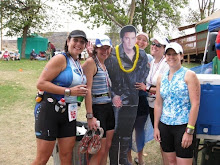by Joel Friel
A triathlete asked me some time ago what he should do on downhill portions of a bike course. Should he pedal hard, pedal easy or coast? That was a great question and one that also applies to cyclists doing time trials. It does not apply to runners as their speed is not significant enough to cause substantial drag.
On a bike as your speed increases linearly (a straight line from, let’s say, 20 to 25 mph), the power required to go faster increases exponentially. This largely is because of drag. The energy required to overcome air resistance (drag) is a function of land speed to the third power. So while it is only a 25% increase in speed to go from 20 to 25 mph, there is something like a 75% increase in the energy required to achieve that additional 5 mph.
Why am I telling you this? Because as you go down hill and your speed increases if you want to go even faster than coasting allows the energy “expense” of the additional miles per hour is going to cost you dearly.
The bottom line is an old adage which says that if you are riding on a fast portion of a course (down hill) ride easy; but if you are riding on a slow portion of a course (up hill) ride hard. So when riding fast on a downhill don’t expend as much energy as when riding uphill. The longer the event, the more important this is. For a sprint-distance triathlon or a short time trial you can go much harder downhill than if it was an Ironman or a long TT.
The best advice I've seen for this came from Alan Couzens, an exercise physiologist and triathlon coach. He tried to nail it down for Ironman triathletes
Coast at >50km/h
Pedal easy at >40km/h
Pedal steady at >30km/h
Pedal moderately hard at >20km/h
Pedal hard at >10km/h
You can read Alan's blog on this topic for an in-depth discussion of how he came up with his rule by going here.
Alan’s Ironman rule may not work for your race distance, but the concept remains the same: Conserve energy when the bike is going fast; expend energy when the bike is going slow. How much energy depends on how fast the bike is going, how long your race is and how fit you are. The less fit you are the more you will need to conserve energy on down hills. Based on this concept you can come up with your own rule for each race distance you do.





















No comments:
Post a Comment